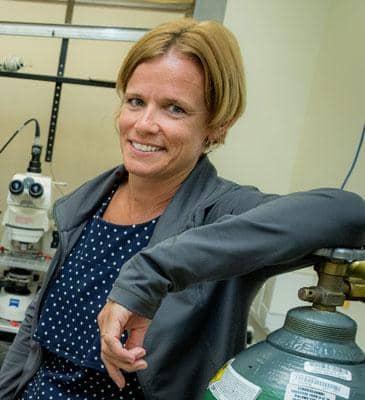Laura Schrader, PhD
Chair and Professor of Cell and Molecular Biology

Biography
Dr. Schrader studies molecular mechanisms of synaptic plasticity and learning and memory. Techniques include: patch clamp electrophysiology in brain slices, behavioral paradigms, molecular biology and biochemistry. Her ultimate goal is to better understand how modulation of ion channels regulates neuronal excitability and synaptic plasticity in the context of learning and memory.
Research
The main research interest in my lab involves investigation of regulation of neuronal excitability by ion channels. This research is relevant to normal plasticity processes, such as learning and memory and pathological processes such as epilepsy. Techniques include: patch clamp electrophysiology in brain slices, behavioral paradigms, molecular biology and biochemistry.
Contributions
Ye W, Wang J, Song Y, Yu D, Sun C, Liu C, Chen F, Zhang Y, Wang F, Harvey RP, Schrader LA, Martin J, and Chen Y-P. (2015) A common Shox2-Nkx2-5 antagonistic mechanism primes the pacemaking cell fate in the pulmonary vein myocardium and sinoatrial node. Development 142:2521-2532
Springer SJ, Burkett B and Schrader LA. (2015) Modulation of BK channels contributes to activity-dependent increase of excitability through MTORC1 activity in CA1 pyramidal cells of mouse hippocampus. Frontiers in Cellular Neuroscience 8:451.
McDermott, CM, Liu, D, Ade, C and Schrader LA. (2015) Estradiol replacement enhances fear memory formation, impairs extinction and reduces COMT expression levels in the hippocampus of ovariectomized female mice. Neurobiology of Learning and Memory 118:167-177.
Sun C, Yu D, Ye W, Liu C, Gu S, Sinsheimer NR, Song Z, Li X, Chen C, Song Y, Wang S, Schrader LA, Chen Y. (2014) The short stature homeobox 2 (Shox2)-bone morphogenetic protein (BMP) pathway regulates dorsal mesenchymal protrusion development and its temporary function as a pacemaker during cardiogenesis J Biol Chem. Dec 8. pii: jbc.M114.619007
Ferland CL, Lam M, Harris, E and Schrader LA. (2014) Facilitation of the HPA axis to a novel acute stress following chronic stress exposure modulates histone acetylation and the ERK/MAPK pathway in the dentate gyrus of male rats. Endocrinology 155(8):2942-52.
Tunur, T, Stelly, CE, Schrader LA. (2013) DREAM/Calsenilin/KChIP3 modulates learning strategy and estradiol-dependent learning and memory. Learning and Memory 20:686-694.
Ferland CL, Hawley WR, Puckett RE, Wineberg K, Lubin FD, Dohanich GP, Schrader LA. (2013) Sirtuin activity in dentate gyrus contributes to chronic stress-induced behavior and extracellular signal-regulated protein kinases 1 and 2 cascade changes in the hippocampus. Biol. Psych. 74:927-935.
McDermott CM, Liu D and Schrader LA. (2012) Role of gonadal hormones in anxiety and fear memory formation and inhibition in male mice. Physiology and Behavior, 105(5):1168-74.
Stelly CE, Cronin J, Daniel JM and Schrader LA. (2012) Long-term estradiol treatment enhances hippocampal synaptic plasticity that is dependent on muscarinic acetylcholine receptors. J. Neuroendocrinol. 24: 887-96.
McDermott CM and Schrader LA. (2011) Activation of kappa opioid receptors increases intrinsic excitability of dentate granule cells. J Physiology, 589: 3517-32.
Tunur T, Dohanich GP and Schrader LA (2010). Pre-exposure to context affects learning strategy selection in mice. Learning and Memory, 17:328-331.
Alexander JC, Bridgeman CM, Tunur T, Rands V, Stelly CE, Karhson D, Bowlby, MR, An WF, Sweatt JD, Schrader LA (2009). The Role of KChIP3 in contextual fear conditioning. Learning and Memory, 16:167-177.
Schrader, LA, Ren Y-J, Cheng F, Bui D, Sweatt JD and Anderson AE (2009). Kv4.2 is a locus for PKC and ERK/MAPK cross-talk. Biochemical Journal, 41: 705-715.
Sol-Collado M, Lyons LC, Levenson JM, Khabour O, Pita-Almenar JD, Schrader LA and Eskin A. (2007) In vivo regulation of an Aplysia Glutamate transporter, ApGT1, during long-term memory formation. J. Neurochemistry 100, 1315-28.
Ren Y, Barnwell FL, Alexander JC, Lubin FD, Adelman JP, Pfaffinger PJ, Schrader LA, and Anderson AE. (2006) Regulation of surface localization of the small-conductance Ca2+-activated potassium channel, SK2 through direct phosphorylation by cylic AMP-dependent protein kinase. J. Biol. Chem. 281, 11769-11779.
Schrader LA, Birnbaum SG, Nadin B, Bui D, Anderson AE, Sweatt JD. (2006) ERK/MAPK Regulates the Kv4.2 Potassium Channel by Direct Phosphorylation of the Pore-forming Subunit. Am J Physiol. 290: C852-61.
Varga, AW, Yuan LL, Anderson AE, Schrader LA, Wu G-Y, Gatchel JR, Johnston D, Sweatt JD. (2004) CaMKII modulates Kv4.2 channel expression and upregulates dendritic A-type potassium currents. Journal of Neuroscience 24:3643-54.
Schrader, LA, Perrett, SP, Ye, L, and Friedlander, MJ (2004) Substrates for coincidence detection and calcium signaling for induction of synaptic potentiation in the neonatal visual cortex. J. Neurophys. 91:2747-64.
Shibata R., Mosono H., Campomanes CR, Anderson AE, Schrader LA, Dolivera LC, Carroll KI, Sweatt JD, Rhodes KJ, and Trimmer JS. (2003) Modulation of Kv4.2 Surface expression by Kv Channel Interacting Proteins. J. Biol Chem. 278: 36445 -36454 .
Schrader, LA, Anderson, AE, Mayne, A, Gutierrez, C, Pfaffinger, PJ, and Sweatt, JD (2002) PKA modulation of Kv4.2-encoded A-type potassium channels requires formation of a supramolecular complex. Journal of Neuroscience 22:10123-10133.
Schrader, LA and Tasker, JG. Presynaptic modulation by metabotropic glutamate receptors of excitatory and inhibitory synaptic inputs to hypothalamic magnocellular neurons. J. Neurophysiol. 77:527-536, 1997.
Boudaba, C. Schrader, LA, and Tasker, JG. Physiological evidence for local excitatory synaptic circuits in the rat hypothalamus. J. Neurophysiol. 77:3396-3400, 1997.
Schrader, LA and Tasker, JG Modulation of multiple potassium currents by metabotropic glutamate receptors in magnocellular neurons of the supraoptic nucleus. J. Neurophysiol. 78: 3428-3437, 1997.
Interests
Investigation of regulation of neronal excitability by ion channels.
